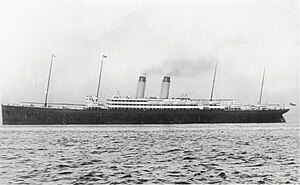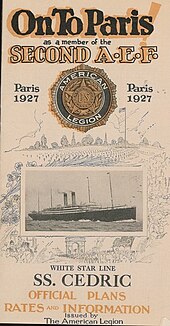RMSCedric
 RMSCedricat sea in 1903[1]
| |
| History | |
|---|---|
| Name | RMSCedric |
| Operator | White Star Line |
| Port of registry | Liverpool |
| Route | Liverpool – New York |
| Builder | Harland & Wolff,Belfast |
| Yard number | 337 |
| Launched | 21 August 1902 |
| Completed | 31 January 1903 |
| Maiden voyage | 11 February 1903 |
| Out of service | 1931 |
| Identification |
|
| Fate | scrappedin 1932 |
| General characteristics | |
| Class and type | Big-Four class |
| Tonnage | 21,035GRT,13,520NRT |
| Length |
|
| Beam | 75.3 ft (23.0 m) |
| Depth | 44.1 ft (13.4 m) |
| Decks | 4 |
| Installed power | 1,524NHP;14,000ihp(10,000 kW) |
| Propulsion |
|
| Speed | 17kn(20 mph; 31 km/h) |
| Capacity | As built: 2,875 passengers (365 first, 160 second, 2,350 third) |
| Crew | 486 officers and crew |
| Notes | Ship colours: black hull with gold line, red boot-topping, upper works white, funnels: White Star Buff |
RMSCedricwas anocean linerowned by theWhite Star Line.She was the second of a quartet of ships over 20,000 tons, dubbed theBig Four,and was the largest vessel in the world at the time of her entering service. Her career, peppered with collisions and minor incidents, took place mainly on the route fromLiverpooltoNew York.
Requisitioned as an auxiliary cruiser in World War I,Cedriccarried out patrol missions until 1916. Her large size being a handicap in this function, she was then transformed into a troop transport and transported soldiers fromEgyptandPalestine,then from the United States in the direction of the European fronts. She then resumed civilian service in 1919.
In the 1920sCedricfaced competition from increasingly modern ships. After having been refitted several times to adapt to new clienteles, she was withdrawn from service in 1931 and scrapped the following year.
History
[edit]Construction and early career
[edit]
At the end of the nineteenth century, White Star Line decided to build large ships at moderate speed, in order to take advantage of the area of comfort and regularity while achieving fuel economy. The first unit of series known as the "Big Four"entered service in 1901,RMSCeltic.A second ship built on the same model was already under construction:Cedric.[3]Built byHarland & Wolffin Belfast as yard number 337,[4]she was launched in Belfast on 21 August 1902, in a private ceremony whose guests includedWilliam Pirrie,the chairman of Harland & Wolff andBruce Ismay,chairman of White Star Line.[5]A month later, a third liner was laid down, theBaltic.[3]
Delivered on 31 January 1903,Cedricmade her maiden voyage on 11 February betweenLiverpoolandNew York City;and she was then the largest liner ever built. She quickly became popular, and while the company insisted that her name be pronounced “seedric”, the public called her “sed-ric”.[4]Her entry into service allowed the company to establish a good service from Liverpool departures on Fridays, and to part ways with its thirty-year-oldBritannic.[6]Throughout her period of service before World War I,Cedricwas mainly used on the route from Liverpool to New York. From 1906, however, she occasionally made cruises between New York and theMediterraneaneach winter and sometimes also between January and March.[4]

Incidents punctuated the beginnings of the ship's career. On 15 March 1905, when a measles epidemic raged aboard, the liner was caught in a storm that damaged the ship, took its bell and shook the furniture in the middle of the panicking passengers.[7]In 1910, the ship also suffered a fire at the quayside, but the damage was negligible.[8]In April 1912, on the other hand,Cedricwas involved in the events followingTitanic's disaster.The president of the White Star, Bruce Ismay, asked that the liner be detained in New York so that the surviving crewmembers ofTitaniccould return to the United Kingdom.[9]
World War I
[edit]
At the start of theWorld War I,Cedricwas one of the ships that were requisitioned and converted intoarmed merchant cruisers,along withCeltic,TeutonicandOceanic.All were assigned to the10th Cruiser Squadronand sent to patrol betweenShetlandandNorway.[10]Cedricwas assigned from November 1914 to patrol A, along withTeutonic.[4]
Cedric's size made her a poor cruiser. In 1916 she was converted into a troop transport, a task more suited to her size. She first transported troops from Egypt and Palestine, then from United States after their entry into the war. From 20 April 1917 to 18 March 1919, she served under the Liner Requisition Scheme and transported, in addition to troops, fuel oil for Royal Navy ships.[11]
On 1 July 1917,Cedriccollided with and sank the French schoonerYvonne-Odettewith the latter losing 24 of her crew. On 29 January 1918,Cedriccollided with and sank theCanadian PacificshipMontrealoff Morecambe Bay.Montrealwas taken in tow, but she sank the next day 14mi(12nmi;23km) from the Mersey Barlightvessel.[12]On 24 July 1919, while the ship was docked in New York, a fire broke out in her No. 6 hold, prompting the intervention of city firefighters who found themselves trapped with crew members. Other teams of police and firefighters were needed to save the victims and bring the blaze under control, while the damage was estimated at $25,000.[13]
Post-war career
[edit]Cedricwas returned to her owner in September 1919 and refitted byHarland & Wolff.She was refitted to accommodate 347 first-, 250 second- and 1000 third-class passengers.[4]In fact, immigration laws in the United States no longer allowed as many third-class passengers to be carried as they did at the turn of the century in a cost-effective manner. From 1919 to 1922,Cedricserved from Southampton, pending the arrival of the new main ships of the fleet,HomericandMajestic.She then resumed her service from Liverpool.[14]
On 30 September 1923,Cedriccollided withCunard Line'sRMSScythiainQueenstownharbourin densefog.Neither vessel was seriously damaged, butScythianeeded to return to Liverpool to be repaired.[15]On 26 December 1924, she was again the victim of a fire affecting a large shipment of Peruvian cotton aboard; the ship was not damaged, but the cargo was lost.[16]Finally, while she was in Boston harbor on 12 September 1926, she struck and severely damaged the river vesselVan.[17]

She continued her regular service between Liverpool and New York in the 1920s. In 1928, with new ships entering service, her age began to show and her first class became a "cabin class".[4]Finally, the arrival in 1930 ofMVBritannicand that ofMVGeorgic,scheduled for 1932, sealed her fate. Her last Liverpool–New York sailing commenced on 5 September 1931 and she was sold later the same year, for £22,150 toThos. W. Wardand scrapped atInverkeithingin 1932.[14]
Characteristics
[edit]In 1901, at 20,904GRTand 13,449NRT,RMSCelticwas the first liner to surpass the size record set in 1860 bySSGreat Eastern.[18]Cedric's profile and dimensions were similar toCeltic's. Her lengths were 700 ft (213.4 m)overalland 680.9 ft (207.5 m) registered. Her beam was 75.3 ft (23.0 m) and her depth was 44.1 ft (13.4 m).[19]ButCedrichad a few more cabins,[4]which increased hertonnagesto 21,035GRTand 13,520NRT[19]Cedrichad two chamois-colored funnels with a black cuff, the hull being black enhanced by a white superstructure (colors displayed by all the company's ships). The funnels were surrounded by four masts which only served to support the lookout's nest (on the front mast) and the cables of the wireless telegraphy.[20]
Internally,Cedricwas decorated and benefited from many luxury amenities of the time. The ship offered lounge, promenade deck, verandah café, reading and writing lounge decorated with large bay windows, smoking room decorated with stained glass windows and dining room topped with a glass roof. The ship also benefited from its own orchestra.[21]Finally, comfort was improved by the low extent of the roll. When commissioned, the ship could accommodate 365 first-class, 160 second-class and 2,350 third-class, for a total capacity of 2,875 passengers.[9]In 1919, its capacity was reduced and it could carry 347 first-class, 200 second-class and 1,000 third-class passengers. Finally, in 1928, she was again converted to carry 300 cabin class passengers, 385 tourist class, and 530 third-class.[4]
The ship was propelled by two propellers powered by quadruple expansion machines generating a power of 14,000 horsepowers. It sailed at an average speed of 16 knots, and could reach a maximum speed of 19 knots. At average speed, the engines consumed 260 tonnes of coal per day, which was significantly lower than most of her competitors.[22]Technically,Cedricstood out from her sister ships by being equipped with the new Welin-type davits (those which were subsequently fitted to many vessels such as those of theOlympic-class ocean liners), instead of the swiveling davits.[9]
Notable passengers
[edit]The leader of theBaháʼí Faith,`Abdu'l-Bahá,travelled aboardCedricfrom Alexandria, Egypt, leaving on 25 March 1912, travelling via Naples, Italy on 28 March[23]and arriving in New York City on 11 April 1912.[24]On 5 December 1912 he travelled onCelticfrom New York to Liverpool.[25]Shoghi Effendi,as a youth 15 years old, accompanied ‘Abdu’l-Bahá from Egypt, disembarking in Italy.[23]
TitanicsurvivorRobert Williams Daniel,a banker who frequently travelled to England on business, returned to New York from Liverpool aboardCedric,arriving on 4 December 1912 to learn of the death that day of his friend and fellowTitanicsurvivorArchibald Gracie IV,whom he was to visit while in New York.[26]
Future garment industry trade union leaderSidney Hillmansailed to the United States (his name was spelledSydney Hilmanon the passenger manifest) as a steerage passenger onCedricfrom Liverpool in August 1907.
References
[edit]Notes
[edit]- ^"Photograph of Cedric, White Star Line".National Museums Liverpool.Retrieved19 June2022.
- ^The Marconi Press Agency Ltd 1913,p. 248.
- ^abAnderson 1964,p. 89
- ^abcdefghHaws 1990,p. 57
- ^"Launch of the Cedric".The Times.No. 36853. London. 22 August 1902. p. 5.
- ^Eaton & Haas 1989,p. 44
- ^Eaton & Haas 1989,p. 72
- ^Eaton & Haas 1989,p. 119
- ^abcde Kerbrech 2009,p. 107
- ^Anderson 1964,p. 124
- ^de Kerbrech 2009,p. 108
- ^Eaton & Haas 1989,p. 182
- ^Eaton & Haas 1989,p. 197
- ^abde Kerbrech 2009,p. 109
- ^Eaton & Haas 1989,p. 198
- ^Eaton & Haas 1989,p. 211
- ^Eaton & Haas 1989,p. 212
- ^de Kerbrech 2009,p. 94
- ^abMercantile Navy List.London. 1904. p. 72 – via Crew List Index Project.
{{cite book}}:CS1 maint: location missing publisher (link) - ^Haws 1990,p. 56
- ^The famous Big Four of the New York - Liverpool Service - White Star Line - 1909 Brochure,GG Archives
- ^de Kerbrech 2009,p. 96
- ^abMahmúd-i-Zarqání, Mírzá; Mohi Sobhani (1997).Mahmúd's Diary.George Ronald.
- ^Lacroix-Hopson, Eliane; `Abdu'l-Bahá (1987).'Abdu'l-Bahá in New York- The City of the Covenant.NewVistaDesign. Archived fromthe originalon 16 December 2013.
- ^Effendi, Shoghi (1979).God Passes By.US Baháʼí Publishing Trust.
- ^"Came to See Col. Gracie".7 December 2012.
Bibliography
[edit]- Anderson, Roy Claude (1964).White Star.Prescot: T. Stephenson & Sons Ltd.OCLC3134809.
- de Kerbrech, Richard (2009).Ships of the White Star Line.Shepperton: Ian Allan Publishing.ISBN978-0-7110-3366-5.
- Eaton, John; Haas, Charles (1989).Falling Star, Misadventures of White Star Line Ships.Patrick Stephens Ltd.ISBN1-85260-084-5.
- Haws, Duncan (1990).White Star Line.Merchant Fleets. Vol. 17. Hereford: TCL Publications.ISBN0-946378-16-9.OCLC50214776.
- The Marconi Press Agency Ltd(1913).The Year Book of Wireless Telegraphy and Telephony.London: The St Katherine Press.
External links
[edit]- .St. Nicholas. Vol. 40. November 1912. pp. 46–51 – viaWikisource.
- "New White Star Line SteamshipCedric"(Marine Engineering,April 1903, pp. 165–170, feature article with photographs.)
- RMSCedric
- Cabin Liners:Celtic / Cedric Interior Tour
- Collision with SV Yvonne-Odette
